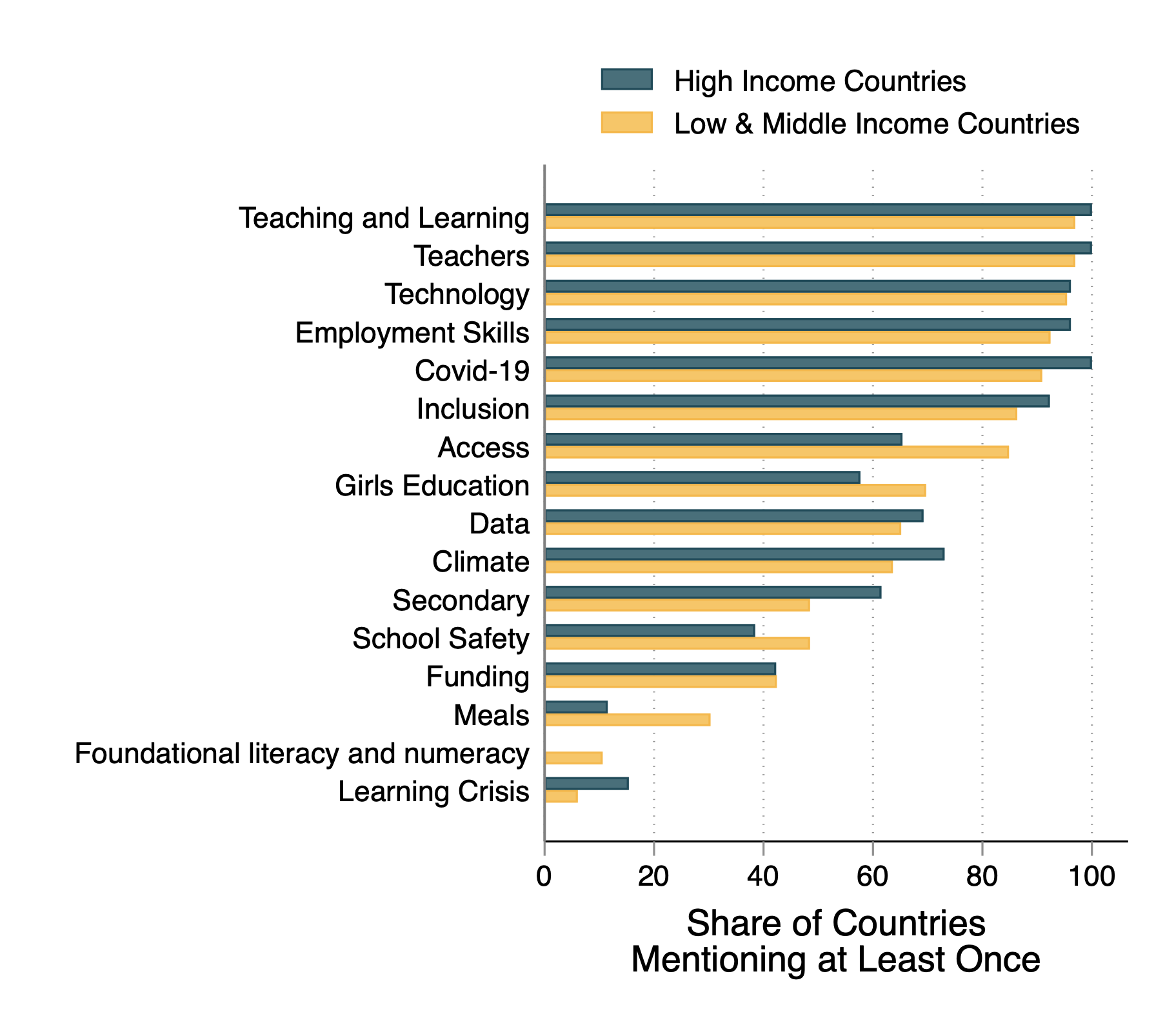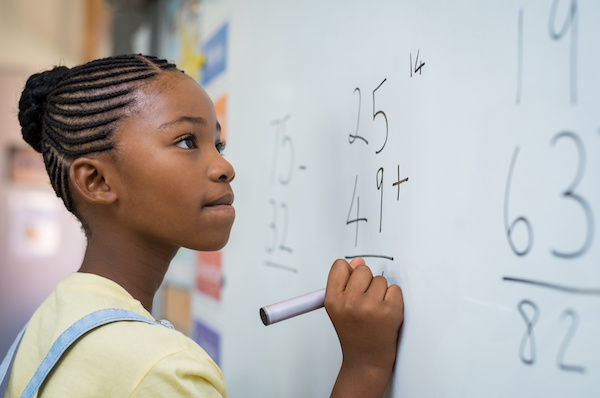Recommended
The education sector needs to know more and do more about violence in schools. Children are exposed to staggering levels of physical, psychological, and sexual violence, perpetrated by teachers, other adults, and students. Many existing efforts focus on girls because—when we consider violence in- and out-of-school—girls are more likely to be victims, including of the most extreme types of sexual violence.
Girls are systematically disadvantaged as a result of their gender, and so it’s right that preventing violence against girls remains a priority. But the scarce data that exists suggests boys are also vulnerable to high levels of sexual abuse—as well as other types of violence—in schools. Paying more attention to violence against boys will also help protect women and girls, since victims of violence often go on to be perpetrators of violence.
Here, we analyse the existing data, highlight some of the areas where we lack data, and suggest that more attention needs to be given to the different types of violence—including the different perpetrators—experienced by boys and girls. It’s very possible that children are suffering much higher levels of school violence than we know. We note that existing survey data may not capture levels of school violence accurately: some evidence suggests that levels of violence are significantly under-estimated, and we don’t know much about which children are most likely to under-report.
Girls and boys suffer shockingly high levels of violence in school
To mount an adequate response to violence in school, we need to know more about how children are affected by different types of violence. Existing data indicate that levels of violence are unacceptably high—nearly a third of children in low- and middle-income countries are regularly exposed to physical or sexual violence–but within this, there are differences by age and gender in the types of violence that children are exposed to.
Physical violence and physical bullying are the most common types of violence in school
Data from the Global School-based Student Health Survey (GSHS) indicates that more boys than girls are victims of physical bullying, defined as being hit by others in the last 12 months (figure 1). Similarly, PISA data from 22 middle-income countries also suggests that more boys than girls are victims of physical bullying (figure 2). The gender difference in exposure to physical violence is often influenced by gendered stereotypes and expectations about masculinity under which boys are expected to be strong and are more prone to aggressive behaviours against other boys.
Figure 1. More boys self-report being victims of physical attacks and physical bullying
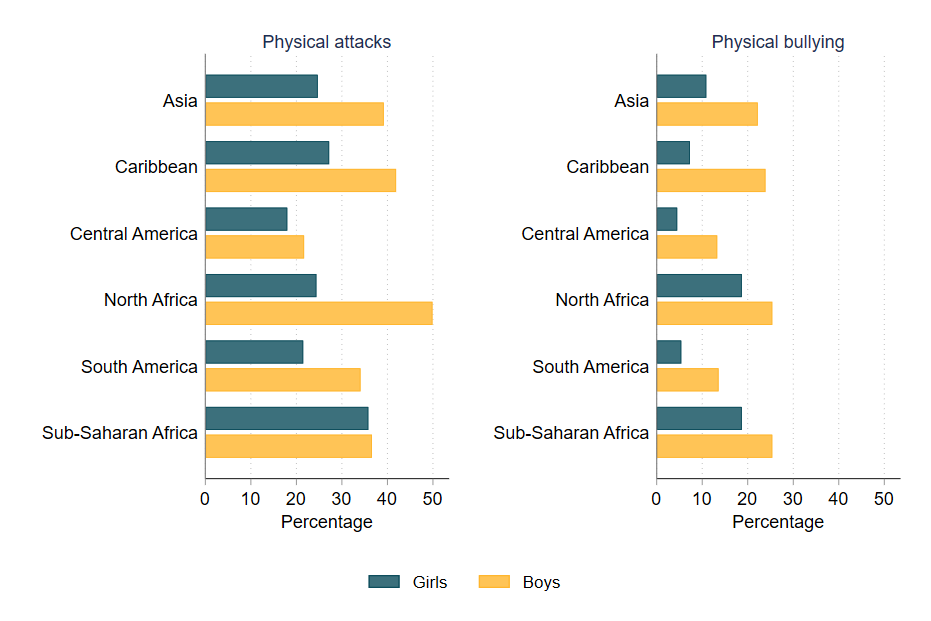
Source: Estimates from UNESCO (2019), which build on GSHS data for 13-15-year-olds, an in-school survey which does not cover students who may have dropped out. Physical bullying refers to being hit, kicked, or pushed around in the last 12 months. Physical attacks refer to actions when one or more people hit or strike a student (including with a weapon such as a stick, knife, or gun).
Psychological bullying—being excluded or verbally abused by peers—is also prevalent in schools. PISA data shows that around 20 percent of students report being victims of this form of bullying several times a month. We see differences between regions, but in most places, boys suffer comparable or slightly higher levels of psychological bullying than girls (figure 2). On the other hand, GSHS data suggests that slightly more girls than boys are victims of psychological bullying. These apparent differences in self-reports of psychological bullying might be influenced by age differences, country coverage of surveys, and the way psychological bullying is defined.
Figure 2. PISA data also show that more boys than girls self-report being victims of physical bullying, as well as regional differences in psychological bullying
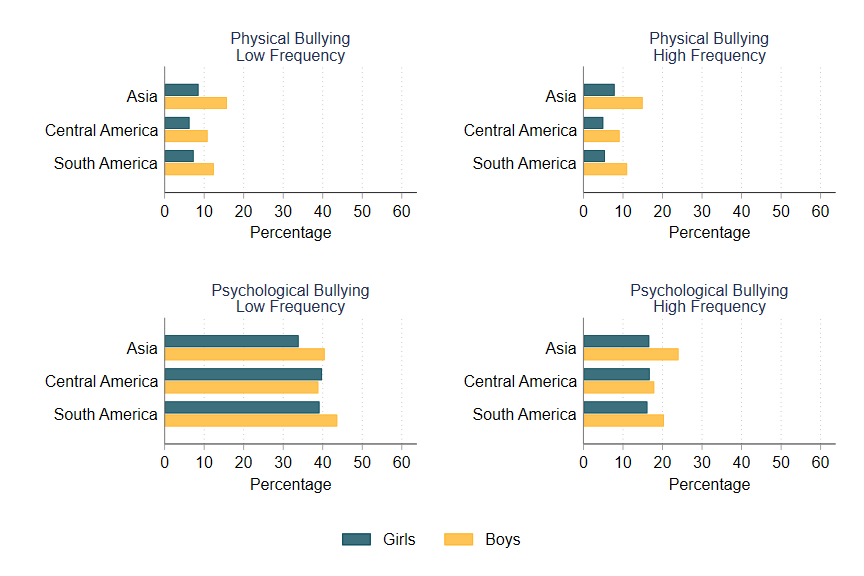
Source: Authors’ analysis of PISA data. PISA survey (2018) asks children aged 15 years the following question on physical bullying: “During the past 12 months, how often have you had the following experiences in school? I got hit or pushed around by other students.” On psychological bullying, the estimate includes answers to the following question: “During the past 12 months, how often have you had the following experiences in school? Other students left me out of things on purpose; Other students made fun of me; Other students spread nasty rumours about me.” Low-frequency bullying considers those that self-report experiencing it a few times a year, while high-frequency bullying considers those that self-report experiencing it a few times a month, once a week, or more.
Much of the data we have focuses on adolescents, but it’s also important to tackle violence against younger children, as many children are exposed to violence in school at much earlier ages. In high-income countries, a couple of studies show that physical and psychological bullying by peers is higher among primary-age children than among adolescents and that the gendered stereotypes that influence these kinds of social interactions are also learned early. ERCE data from countries in Latin America and the Caribbean also suggests that physical bullying is inversely associated with age: 37 percent of 3rd graders, compared with 26 percent of 6th graders, are victims of physical bullying. Meanwhile, older children are more exposed to psychological bullying by peers.
It’s likely that some groups of children, especially LGBTQ+ children, are especially vulnerable to physical and psychological bullying. We have found no systematic data sources in low- and middle-income countries revealing the true scale of this problem, but from what we know from a few single-country studies, it’s clear that LGBTQ+ students face high levels of bullying in school. For example, in Argentina, 45 percent of transgender students dropped out of school due to bullying or exclusion by the school.
Corporal punishment by teachers remains rife, even where it is banned
Corporal punishment by teachers is legal in 63 countries—including the six most populous countries in the world. Even where it has been banned, it remains common across many low- and middle-income countries. Analysis of the Violence Against Children and Youth Surveys (VACS) shows heterogeneity by country in the prevalence of corporal punishment against girls and boys (figure 3). Data from the Young Lives Survey in four countries indicates that boys are more likely than girls to experience corporal punishment and that 8-year-old children are more vulnerable to corporal punishment in schools than 15-year-olds.
The gender differences by country, as well as the prevalence of corporal punishment against young children, suggest that we need country-specific policies and interventions to change traditional norms that endorse the use of violence by teachers.
Figure 3. Prevalence of corporal punishment against boys and girls varies by country
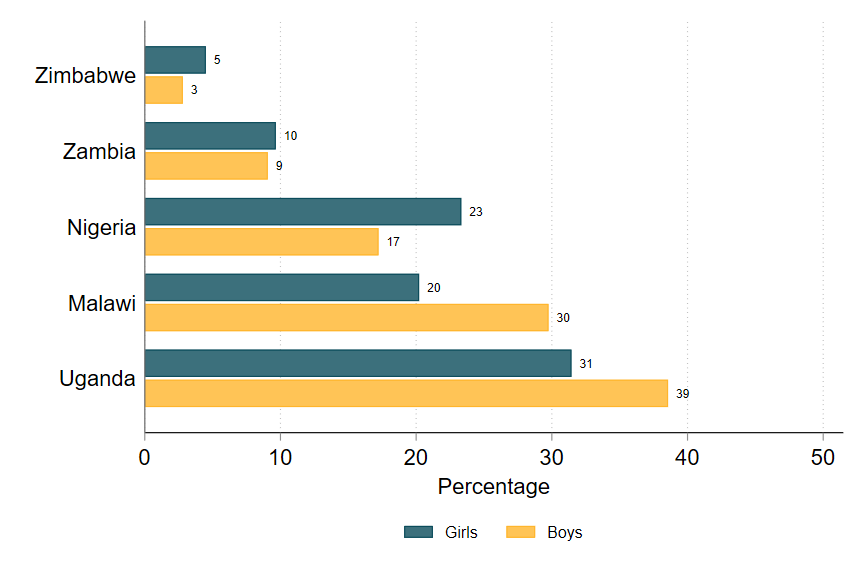
Source: Authors’ analysis of VACS data, reported as experienced in the last 12 months by children aged 13-17. Differences between girls and boys are statistically significant (p=0.000) in Nigeria, Malawi, and Uganda.
Girls are more vulnerable to sexual violence, including the most extreme types of sexual violence
While corporal punishment remains legal in some countries, sexual violence is not legal anywhere and yet it remains highly prevalent. It is difficult to obtain reliable data about the scale and nature of sexual violence committed against children. Indeed, we suggest that under-reporting may be most acute for sexual violence; confidentiality concerns and fears of retaliation could suppress reporting even more than with other types of violence. Deeply rooted cultural norms may mean that children—especially girls—are not aware of their right to be safe from sexual violence and therefore do not report it. Only a few surveys collect data on sexual violence. “Catch-all” terms in surveys do not differentiate between types of sexual violence, for example between sexual harassment and rape.
The survey that gives us the best insights into rates of sexual violence is the VACS. We analyse the data for seven low- and middle-income countries and find that rates of sexual violence differ significantly by country, but are shockingly high for both girls and boys, with up to a quarter of girls experiencing sexual violence in the last 12 months. Of those who experienced sexual violence, up to 40 percent of boys and 20 percent of girls reported experiencing it at school (figure 4).
Figure 4. Girls suffer more sexual violence than boys; but of those who experience sexual violence, a higher proportion of boys experience it in school
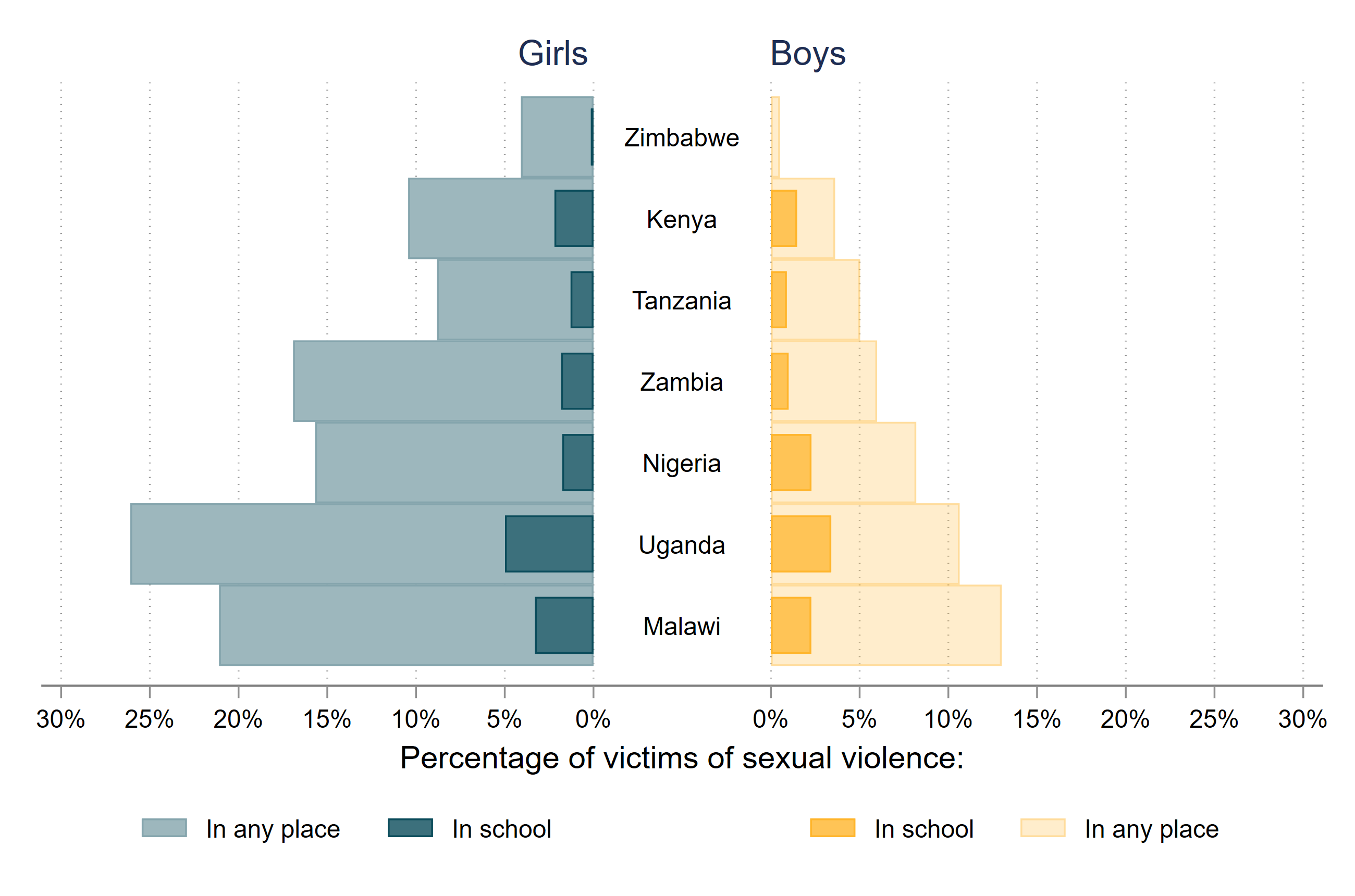
Source: Authors’ analysis of VACS data, reported as experienced in the last 12 months by children aged 13-17. The light teal and light yellow bars indicate the percentage of girls and boys, respectively, that report being victims of sexual violence at any location (including schools). The dark teal and dark yellow indicate the percentage of girls and boys that report experiencing it at school, respectively.
The VACS data also allows us to analyse the type of sexual violence experienced by girls and boys (figure 5a). While we consider all types of sexual violence as traumatic, forced sex is perhaps the most traumatic and likely has the most serious consequences for victims. Girls are much more likely to experience forced sex than boys. Across six of the seven countries in our sample, more than 10 percent of girls who have experienced sexual violence in the last 12 months were raped.
Whilst girls and boys are both exposed to unacceptable levels of sexual violence in school, they are less likely to suffer the more extreme types of sexual violence there than they are outside of school (figure 5b). The most common types of sexual violence that children are exposed to in school are unwanted touching and unwanted attempted sex.
Figure 5. Among those that self-report sexual violence, girls are more vulnerable to the most extreme types of sexual violence
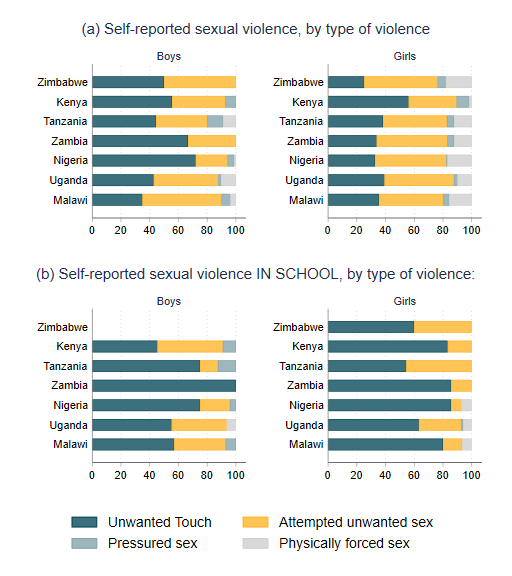
Source: Authors’ analysis of VACS data. Figure (a) shows the self-reported experiences of sexual violence by type in the last 12 months by children aged 13-17, in school or out-of-school. Figure (b) shows the self-reported experiences of sexual violence by type in the last 12 months by children aged 13-17, in school. In Zimbabwe, none of the cases of sexual violence against boys happened in school.
Some other surveys shed further light on sexual violence against girls and boys in school. The GSHS survey suggests boys and girls aged 13 to 15 years suffer similar levels of sexual bullying at school—defined as being made fun of with sexual jokes, comments, or gestures. And PISA for Development data across seven low- and middle-income countries indicates that boys and girls are similarly vulnerable to sexual harassment—defined as unwanted or inappropriate language or touching of a sexual nature by teachers and students (figure 6).
What is clear is that girls are more exposed to the most severe types of sexual violence and may suffer more consequences of sexual violence, including community rejection, gynaecological conditions, and unwanted pregnancies. So it’s right that girls are prioritised in gender-based violence programs. But we shouldn’t overlook that boys are also vulnerable to sexual violence from their peers and from teachers.
Figure 6. Girls and boys report similarly high levels of sexual harassment by teachers and other students in the last four weeks
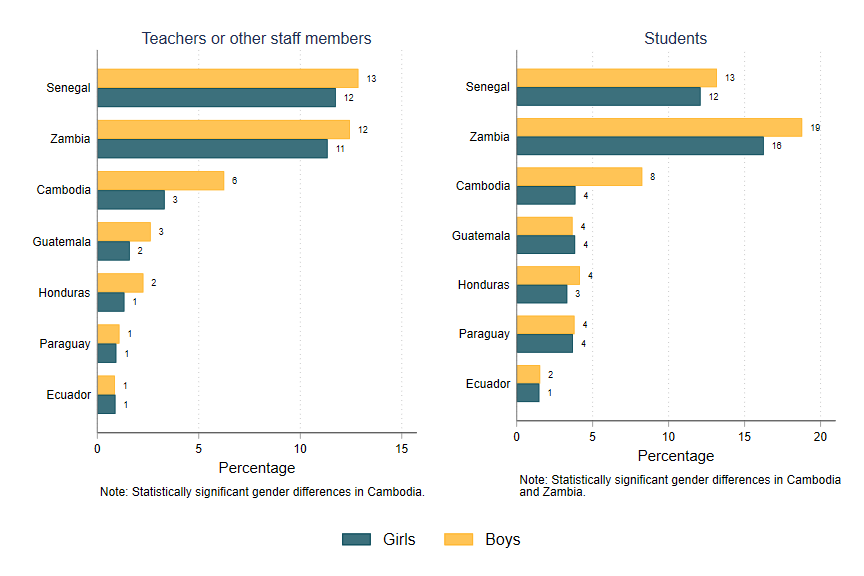
Source. Authors’ analysis of PISA for Development data.
We don’t know enough about who is perpetrating violence against children in schools
To eliminate violence against children, we need to know who is perpetrating violence and where and why they’re doing it. With the exception of VACS, cross-national surveys generally only ask whether the perpetrators were teachers or students, but do not include questions on the gender of the perpetrators.
Overall, students are the second most common perpetrator of physical and psychological violence against children, after household members. Evidence from comparative studies in high-income countries, as well as in country-specific studies suggests that boys carry out most of the bullying against boys and girls, whereas girls mainly bully against other girls. The existing research also suggests that boys use physical means to bully others more often, whereas girls tend to use verbal abuse. These different roles of boys and girls as perpetrators are influenced by notions of masculinity and femininity that are often reinforced in schools.
VACS data suggests that male teachers are the main perpetrators of corporal punishment against children in school. And in Malawi, Nigeria, Zambia, and Zimbabwe, male teachers perpetrate far more sexual violence in school than female teachers, with almost no reported cases of sexual violence committed by female teachers.
It’s vital to understand who is perpetrating violence against children so we can find better ways to protect those children. But we also need to do more to break the cycle of violence and stop child-perpetrators from going on to be adult-perpetrators.
Many children do not disclose violence in surveys, and many do not report violence after they experience it
Many victims of school violence do not report it when responding to surveys and nor do they report it immediately after experiencing it. Almost all surveys use face-to-face direct eliciting questions—in other words, they ask children directly whether they have been victims of school violence. Often, children will not feel comfortable answering these questions as they might have concerns about confidentiality and retaliation. As a result, many will not disclose their experience of violence. There are very few studies exploring the problem of misreporting of school violence. One study in Uganda compares face-to-face survey methods with other methods that provide greater anonymity—such as sealed-envelope methods—and shows that methods perceived to be more confidential lead to more reports of sexual violence, in or out of school. This probably differs by country, and we should be aware that country-specific social norms will influence children’s likelihood of disclosing violence. It’s possible that the data we have vastly underestimates the scale of violence in school.
Beyond measuring the problem, many children do not report violence after it happens. Studies in high-income countries show that between 30 and 70 percent of students do not report violence at school, either to members of the school staff or to parents. Boys and older students are less likely to speak up. This means children are suffering egregious acts of violence and getting no support to cope with it. We have little data on this from low- and middle-income countries, with the exception of VACS. Respondents are asked whether those who experienced physical or sexual violence (in or out of school) told anyone about it. In Malawi, Nigeria, Uganda, Zambia, and Zimbabwe, 50 percent of the victims aged 13 to 17 years old did not talk about their experience to others, with boys being less likely to speak up (figure 7).
Some barriers to reporting violence are common for boys and girls, such as information on where to report, trust in school staff’s ability to help, fears of retaliation, and rejection by peers. Others are gender-specific, particularly the social and cultural barriers that are influenced by gender norms and stereotypes. Reducing these barriers to reporting is a necessary but challenging step toward eliminating violence in school.
Figure 7. Girls are slightly more likely to report incidents of violence
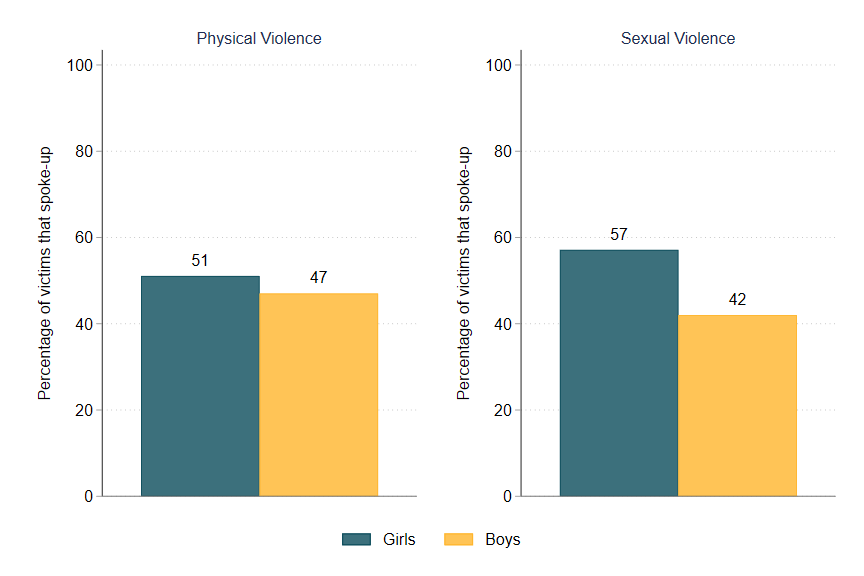
Source: Authors’ analysis of VACS data for Malawi, Nigeria, Uganda, Zambia, and Zimbabwe. Percentage estimated based on responses to the following survey question: “Did you tell anyone about any of these experiences?” Mean differences between boys and girls are statistically significant (p-values=0.000).
To eliminate violence against children, we need to know more about how violence affects girls and boys in different ways
School violence starts at an early age and affects girls and boys in different ways. To eliminate violence against all children, we need to address the gender expectations, norms, and stereotypes that influence the perpetrator-victim dynamic between students and teacher-to-student. And we need to tackle violence against boys, as part of the response. Children must be safe in school and the education sector must do more.
Firstly, we need to know more about when, how, and where violence happens, through better survey data. Current survey data mainly focuses on older children, and is predominantly about physical and psychological violence. We know little about the perpetrators and little about sexual violence. Plus, it’s very possible that the survey methods used are significantly under-estimating violence.
Secondly, we need to learn more, through more rigorously evaluated interventions that target the differential exposure to and impact of violence on girls and boys. We don’t have enough knowledge about what works to prevent violence in school, particularly models that can be scaled by governments.
Thirdly, we need to do more. Safety in school is the very minimum anyone working in global education should accept and the elimination of violence should be prioritized above other interventions. But interventions that address school violence as solely or primarily an issue affecting girls are not sufficiently tackling the harm caused by violence nor the root of the problem. The UK FCDO’s education strategy 2021-2026 includes lots of good stuff on preventing violence against girls, but barely references violence against boys. The 2022 US Strategy to Prevent and Respond to Gender Based Violence Globally, on the other hand, is clear that eliminating violence against boys must be a core part of the response.
Schools should provide a safe and nurturing environment where children are able to learn and thrive. But, in a perversion of this role, children are often harmed and abused in schools. We need to better understand girls’ and boys’ exposure to school violence as victims and perpetrators, as well as how likely they are to disclose acts of violence committed against them. We also need to know much more about the vulnerability of specific groups of children—including LGBTQ+ children—to different types of violence. This needs to happen, urgently. All our efforts to get more children in school and learning will be worth little if children don’t have a safe place to learn.
Thank you to Antara Ganguli, Nicole Haberland, Pauline Rose, Sameer Sampat, and CGD colleagues for their helpful comments. Thank you to Dongyi Wu for excellent research assistance. All errors are our own.
Rights & Permissions
You may use and disseminate CGD’s publications under these conditions.


